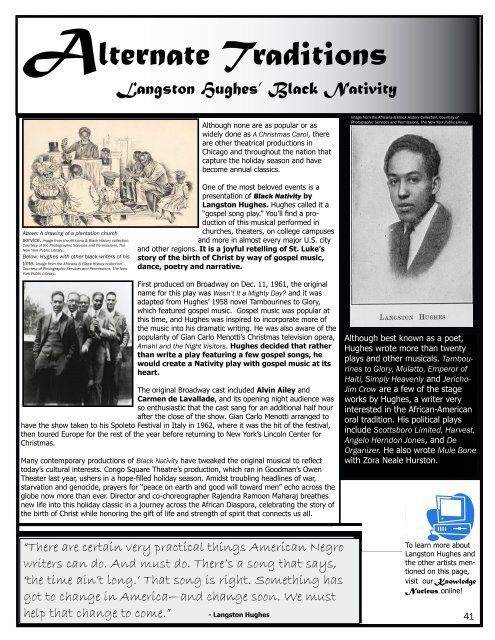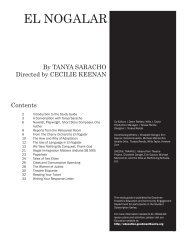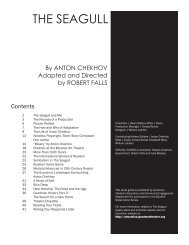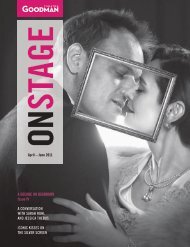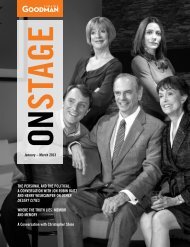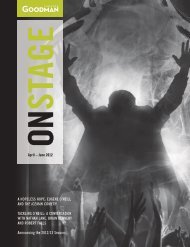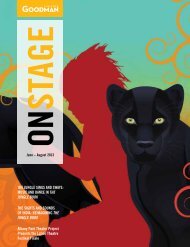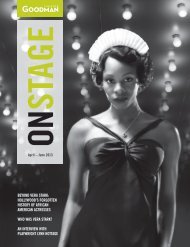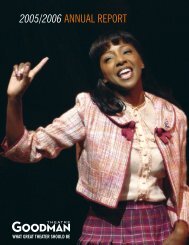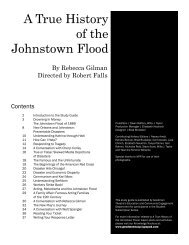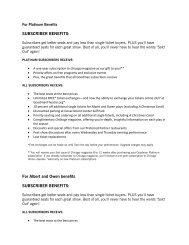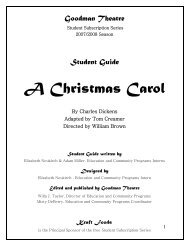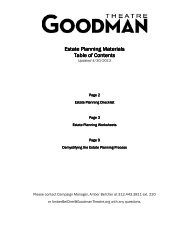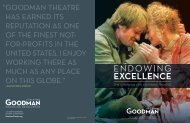A Christmas Carol Study Guide.indd - Goodman Theatre
A Christmas Carol Study Guide.indd - Goodman Theatre
A Christmas Carol Study Guide.indd - Goodman Theatre
Create successful ePaper yourself
Turn your PDF publications into a flip-book with our unique Google optimized e-Paper software.
Alternate Traditions<br />
Langston Hughes’ Black Nativity<br />
Although none are as popular or as<br />
widely done as A <strong>Christmas</strong> <strong>Carol</strong>, there<br />
are other theatrical productions in<br />
Chicago and throughout the nation that<br />
capture the holiday season and have<br />
become annual classics.<br />
Image from the Africana & Black History Collection. Courtesy of<br />
Photographic Services and Permissions, The New York Public Library.<br />
Above: A drawing of a plantation church<br />
service. Image from the Africana & Black History collection.<br />
Courtesy of the Photographic Services and Permissions, The<br />
New York Public Library..<br />
Below: Hughes with other black writers of his<br />
time. Image from the Africana & Black History collection.<br />
Courtesy of Photographic Services and Permissions, The New<br />
York Public Library..<br />
One of the most beloved events is a<br />
presentation of Black Nativity by<br />
Langston Hughes. Hughes called it a<br />
“gospel song play.” You’ll find a production<br />
of this musical performed in<br />
churches, theaters, on college campuses<br />
and more in almost every major U.S. city<br />
and other regions. It is a joyful retelling of St. Luke’s<br />
story of the birth of Christ by way of gospel music,<br />
dance, poetry and narrative.<br />
First produced on Broadway on Dec. 11, 1961, the original<br />
name for this play was Wasn’t It a Mighty Day? and it was<br />
adapted from Hughes’ 1958 novel Tambourines to Glory,<br />
which featured gospel music. Gospel music was popular at<br />
this time, and Hughes was inspired to incorporate more of<br />
the music into his dramatic writing. He was also aware of the<br />
popularity of Gian Carlo Menotti’s <strong>Christmas</strong> television opera,<br />
Amahl and the Night Visitors. Hughes decided that rather<br />
than write a play featuring a few gospel songs, he<br />
would create a Nativity play with gospel music at its<br />
heart.<br />
The original Broadway cast included Alvin Ailey and<br />
Carmen de Lavallade, and its opening night audience was<br />
so enthusiastic that the cast sang for an additional half hour<br />
after the close of the show. Gian Carlo Menotti arranged to<br />
have the show taken to his Spoleto Festival in Italy in 1962, where it was the hit of the festival,<br />
then toured Europe for the rest of the year before returning to New York’s Lincoln Center for<br />
<strong>Christmas</strong>.<br />
Many contemporary productions of Black Nativity have tweaked the original musical to reflect<br />
today’s cultural interests. Congo Square <strong>Theatre</strong>’s production, which ran in <strong>Goodman</strong>’s Owen<br />
Theater last year, ushers in a hope-filled holiday season. Amidst troubling headlines of war,<br />
starvation and genocide, prayers for “peace on earth and good will toward men” echo across the<br />
globe now more than ever. Director and co-choreographer Rajendra Ramoon Maharaj breathes<br />
new life into this holiday classic in a journey across the African Diaspora, celebrating the story of<br />
the birth of Christ while honoring the gift of life and strength of spirit that connects us all.<br />
Although best known as a poet,<br />
Hughes wrote more than twenty<br />
plays and other musicals. Tambourines<br />
to Glory, Mulatto, Emperor of<br />
Haiti, Simply Heavenly and Jericho-<br />
Jim Crow are a few of the stage<br />
works by Hughes, a writer very<br />
interested in the African-American<br />
oral tradition. His political plays<br />
include Scottsboro Limited, Harvest,<br />
Angelo Herndon Jones, and De<br />
Organizer. He also wrote Mule Bone<br />
with Zora Neale Hurston.<br />
“There are certain very practical things American Negro<br />
writers can do. And must do. There’s a song that says,<br />
‘the time ain’t long.’ That song is right. Something has<br />
got to change in America—and change soon. We must<br />
help that change to come.”<br />
- Langston Hughes<br />
To learn more about<br />
Langston Hughes and<br />
the other artists mentioned<br />
on this page,<br />
visit our Knowledge<br />
Nucleus online!<br />
41


